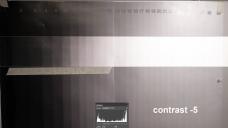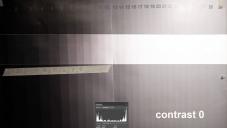
-
I've found with my GH3 that the color of the video on the camera screen is perhaps just a bit warm, but not that much from what I'll see in Premiere-Pro. But I do use that screen to check primarily the "vertical" axis on the adjustment screen's "G-M" setting. Try to get the "A-B" set in manual WB mode to reasonable, then using the vertical "G-M" to balance between green/magenta ... my GH3 doesn't seem to pay attention to the "G-M" when setting a wb, and that's where I can get the nastiest hues to try to recover from.
Neil
-
Are you using external calibrated monitor or are you trusting of GH3 screen when shooting. In my tests I trust more on camera auto white balance than GH3 screens. Those OLEDs can show anything weird. When I go home and watch clips with good monitors I am usually happy with WB.
Is it almost same thing to set OLED color to max to see color errors?
One annoying thing with GH3 is that you cannot program picture control to any of "hundreds of" Fn-buttons!!
-
@starios, I was thinking take first image with WB calibrated with your +2 contrast and +5 saturation, then adjusted to -5's to take the shot, vs. an image where WB was calibrated with camera already set to -5's. I'll run my own tests, but I guess I was assuming based on your previous post that you had already done side-by-side comparisons.
I have been shooting at all -5's, with the exception of keeping saturation at -2. But I also personally like keeping NR down - I prefer a little noise to emulate film grain, though I recognize that might not suit everyone's taste. I have certainly noticed a major reduction in moire, which was initially the most disappointing factor in my film-to-gh3-digital transition, by keeping sharpness dialed all the way down it is much less of an issue.
-
I also noticed something but I may be wrong. In "perfect" wb, shooting all in -5 image has contrast, probably because there is no color on top to flatten everything.
-
@larrysanders I don't know if it's common practice, I just tested it and it works for me. I can't think of a way to shoot an example for wb. One shot right wb and one wrong??? :) but maybe it could be a way to set wb in any camera, at least now I can get rid of the extremes (especially red at night) with more balance in one by one color intensity.
-
@starios ,
that's interesting idea, can you post test results? As anyone else done these type of tests? I'm a relatively new gh3 shooter, was primarily shooting 16mm for the past 10 years, apologies for my ignorance but is this common practice to adjust settings for WB, then re-adjust for shooting? I can see where boosting saturation when taking the initial WB reading could potentially have a significant effect.
-
I think I found a way to setup white balance. Before wb set +2 contrast and +5 saturation and then, if I conclude correctly, the camera shows better the direction of color and the way it catch rgb. It is much easier to set the wb and the extra adjustment in, yellow, magenda... Then, you shoot as flat as you feel, everything -5 or whatever.
-
@vesku, nothing electrical, nothing automatic, no light involved. Tomorow I will check with a gh3 of a friend of mine, I'tell you, but it is not normall at all....
-
I wish Shian had stuck with working with the GH3 a little more so we could have a ColorGhear for it. I found his GH2 Green Kill ColorGhear perfect for correcting the GH2's green cast.
-
I've worked with both Standard and Neutral ... prefer "standard" and have played with the settings some ... though who hasn't?
I white balance with an Expodisc Neutral ... seems to work great, though I'm craving a OneShot card ... but an accurate starting WB seems the only start ... you can't "bend" the files too much from that. If I want an altered tone, I will play with K and the grid settings ...
Yea, too low a contrast and you get more a bit more shadow and highlight range (though not THAT much) at the cost of what seems to be bunching tones in the upper mids ... right where middle & highlighted skin "live".
Too low a saturation and the colors aren't quite ... right ... somehow on pushing in post.
Too low contrast and too low saturation combined seems to really help the sensor "bunch" skin-type tones, but ... it does it more with skintones than other colors. So I am thinking it's something the processor does if it thinks it's got "skin" by color & tonal value.
I don't take contrast below -3 anymore nor sat below -2. I try to lift contrast in the mids/upper mids slightly in post, and for skintones, yellow hue a bit away from green, and magenta a bit away from blue. Or I can get the mostly blue-ish/magenta plasticene look that occasionally tilts a bit yellow green.
Neil
-
@wgtwo good question.. I worked with natural until a few days ago, but now i reconsidered the vivid profile (-3, -3, -1, 0)
-
That flicker thing seems to be not normal. Are you using movie mode or automatic PASM modes. 24P or 50/60P. is there electrical lights in scene. I think your camera may be broken. Can you go to store to compare to other GH3?
-
I found the answer, but is a little bit frustating. It is a matter of light coming to the sensor, I deal with the flickering pushing up the iso,at 1600 iso flickering desapears, that increase noise but flicker or banding desapear. Was new fir me, because gh2 never saw this, and seems is something i need to get use. The monitor or lcd doesnt show ( getting use to it) me a good way to nail the exposure. Another dificult situation is when in super contrasty situation I need to preserve the lights then in darker zones flickering or banding come alive again. I need more test, with proper lighting interviews etc.. Exposure seems a lot harder than gh2, what do you think? The last shot I made was against a balcony, preserving the highlight exterior made a total mess of flicker interior. Only at 1600 iso at noise cost fix the problem,.That makes an unusable camera for me, at least for weddings and events. Is happening to you? I have time to send back the camera..
-
Guys, had you got problems with flickering? I tried to shot interior with only light from the vindow and I couldn´t get a shot without terrible flick.No matter wich mov flavor, SS etc... with manual lenses, everything manual, no idinamic, nothing auto...I can´t believe it. Seems like darker and uniforma parts of the scene start flickering ,like it doesnt can take light and sadows from the interior...totally lost..
-
Any consensus on which colour profile is best? Standard? Natural?
-
I don't know Vesku, buy whit this method I had good separation of skin tones independently of wich exposure. With falsecolor the flesh skin tones of the oneshot card kept a diferent exposure, and only one was in the same range of middle gray, seems like resolve the problem of @yak, our problem at the end. Or I hope so, because I didn't try in a real flesh face, anly in charts....give a try and tell me if it works or not... In gh2 worked for get away of greenish, why not in gh3? Exactly @flalblo, but in camera
-
The m8 b6 technique must be similar to using the minus green filter, just like here http://www.personal-view.com/talks/discussion/8113/speedbooster-gh2-with-cc30m-sensor-mod-fishing-trip-/p1
-
How about contrast -5 and underexposure 1/3 or 2/3. Thats my way especially with dark backgrounds. When there is white or light backgroud then 0 or +1/3. I would not dial color down more than 1 step because contrast itself dials color down.
-
@yak my issue exactly. It seemed that all areas of face become one, like under the eyes losing contrast with the forehead for example. Where in reality under the eyes would be much darker to the forehead.
-
@fran I'm going to gave it a try
But the skin tones issue for me was never the skin color but the way it seems to all fall in the same range of mid-tones creating muddy, clayish skins.
-
Yes, what I was trying to achive is that maybe I can go as flater as I can with all -5 without have plastic yellowish flesh tones when I get back everything in post trying to recovering information. And I achived by getting the right balance in kelvin ( but first doing one manual to see what was the right exactly ). Then I dial m8 b6 and memorize it in C1 or wherever memory I'm working. Watching my Oneshort card with the fleshtones and the other stuff in gh3 lcd and external monitor then I started push contrast, saturation up and down in several pictures estiles and never saw yellow in the fleshtone frame and the colour seems to be acurate with or without saturation or contrast up or down. So it leads me to think that as well ( I haven't had time to test it ) in post with curves or whatever method I can recover information without messing with plastic or yellowish flesh tones. Maybe it helps with that and we can shoot really flat, not just -3-3-3-0 to take care of midtones or flesh tone tinted in to recovery process. So, maybe flatering contrast is not the problem on flesh issues, maybe is white balance and maybe do this color correction inthe same camera helps to preserve good flesh tones. I think I can experiment more on this, but this fast test, tell it could be posible and m8 b6 can saves us some headaches
-
Hi Fran, thanks for your investigations! So you are saying that no matter what contrast (-5 0 or +5) etc are set to if we manually adjust kelvins to correct white balance THEN adjust colour to m8 b6 it fixes the skin tones issue? Surely this could be done in post by pushing colours towards blue and magenta? Please explain the process further if possible.
-
Hello everybody, I'm new with my gh3, coming from gh2 background. Yes, the ELF sucks!! Reading your posts about profiles I was very worried because I even didnt use it in a proper job. All the stuff about skin was scary! So I decided to made a short try and error. I took the Oneshot card, a grey card, a white, some black cloth, colour chart for photo with several colors, my gh3 an hdmi and a monitor calibrated wich have false color to on it. Well it was only a random and fast test. And maybe I'm totally wrong. I will do it again slowly and I will put all the footage in resolve and chack it all with scopes. But said that, I found that is nothing wrong with the profiles natural or standar it was a matter of whie balance, I tried severals up and down contrast sharpen etc and i found all were doing wrong things with the flesh tones, Specially going yellowish in caucasian frame when going up and down in contrast, sharpen etc...So, as with my gh2, I made a proper white balance ( the gray card and the white give the same result ) and then tried to match the same manually in the kelvin WB, but this time once it was more or less the same I dialed in kelvin color knob b6 and M8. In gh2 we used to go to magenta -2 -2 to get ride of green, but in gh3 this numbers work perfect to getgood skin tones, at least in my oneshotcard. All the yellowish disapier and dialing sharpen contrast etc didn't affect in colours tint. Please, try in real world and tell me. Actually very bussy. For me worked. I put all at -5 and then tried all 5 and the flesh and colour was recovered and without yellow in flesh. So, for me is more about proper balnce and get ride of the yellow in the flesh. All -5 and let everything for post. Hope it works and help! It was a too fast test and wanted to share the the pw users, sorry if I'm wrong.
-
In my tests contrast setting affects clearly dynamic range. Here I shooted with Natural -5, 0 and +5 and you can see the difference in DR. I included luminance histogram and boosted gamma adjustment in the middle of frame.

 contrast-5.jpg1916 x 1078 - 164K
contrast-5.jpg1916 x 1078 - 164K
 contrast-0.jpg1912 x 1076 - 158K
contrast-0.jpg1912 x 1076 - 158K
 contrast+5.jpg1918 x 1079 - 161K
contrast+5.jpg1918 x 1079 - 161K -
@yak I agree, -5 is noisier in those samples, I believe it's because contrast applied before video compression so it leads mids to blacks, it is very interesting that -5 is noisier in those situations, but I usually try to do the opposite, leading mids to highlight because of my need for dynamic range, if you try this, and that's exactly what I tried to show in my test, you'll see the opposite effect. Both make sense, we just have to know what we are going to do in post before shooting. @Sph1nxster big difference in high isos, if light is extremely low in my opinion nr is needed
Howdy, Stranger!
It looks like you're new here. If you want to get involved, click one of these buttons!
Categories
- Topics List23,993
- Blog5,725
- General and News1,354
- Hacks and Patches1,153
- ↳ Top Settings33
- ↳ Beginners256
- ↳ Archives402
- ↳ Hacks News and Development56
- Cameras2,368
- ↳ Panasonic995
- ↳ Canon118
- ↳ Sony156
- ↳ Nikon96
- ↳ Pentax and Samsung70
- ↳ Olympus and Fujifilm102
- ↳ Compacts and Camcorders300
- ↳ Smartphones for video97
- ↳ Pro Video Cameras191
- ↳ BlackMagic and other raw cameras116
- Skill1,960
- ↳ Business and distribution66
- ↳ Preparation, scripts and legal38
- ↳ Art149
- ↳ Import, Convert, Exporting291
- ↳ Editors191
- ↳ Effects and stunts115
- ↳ Color grading197
- ↳ Sound and Music280
- ↳ Lighting96
- ↳ Software and storage tips266
- Gear5,420
- ↳ Filters, Adapters, Matte boxes344
- ↳ Lenses1,582
- ↳ Follow focus and gears93
- ↳ Sound499
- ↳ Lighting gear314
- ↳ Camera movement230
- ↳ Gimbals and copters302
- ↳ Rigs and related stuff273
- ↳ Power solutions83
- ↳ Monitors and viewfinders340
- ↳ Tripods and fluid heads139
- ↳ Storage286
- ↳ Computers and studio gear560
- ↳ VR and 3D248
- Showcase1,859
- Marketplace2,834
- Offtopic1,320









